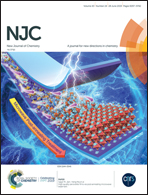Theoretical investigations of the reactivity of neutral molecules that feature an M![[double bond, length as m-dash]](https://www.rsc.org/images/entities/char_e001.gif) M (M = B, Al, Ga, In, and Tl) double bond†
M (M = B, Al, Ga, In, and Tl) double bond†
Abstract
The geometry, the electronic structure and the reactivity of compounds that feature a central M![[double bond, length as m-dash]](https://www.rsc.org/images/entities/char_e001.gif) M (M = group 13 element) double bond with two sterically bulky ligands (L1 = tBu2MeSi and L2 = NHCiPr), L1L2M
M (M = group 13 element) double bond with two sterically bulky ligands (L1 = tBu2MeSi and L2 = NHCiPr), L1L2M![[double bond, length as m-dash]](https://www.rsc.org/images/entities/char_e001.gif) ML1L2 (Rea-MM) are studied at the B3LYP-D3(BJ)/def2-SVP level of theory. The computational results show that the presence of a lighter group 13 M element (such as B, Al, and Ga) in Rea-MM results in a significant E
ML1L2 (Rea-MM) are studied at the B3LYP-D3(BJ)/def2-SVP level of theory. The computational results show that the presence of a lighter group 13 M element (such as B, Al, and Ga) in Rea-MM results in a significant E![[double bond, length as m-dash]](https://www.rsc.org/images/entities/char_e001.gif) E double bond character and a planar structure. However, Rea-InIn and Rea-TlTl adopt a trans-bent structure, which weakens the M
E double bond character and a planar structure. However, Rea-InIn and Rea-TlTl adopt a trans-bent structure, which weakens the M![[double bond, length as m-dash]](https://www.rsc.org/images/entities/char_e001.gif) M double bond. The ETS-NOCV (extended transition state-natural orbitals for chemical valence) method is used to determine the key factors that affect the reactivity of Rea-MM for its [2+2] cycloaddition reaction with ethylene. The ETS-NOCV analysis shows that only Rea-BB is inert in this cycloaddition reaction because it has large destabilizing interactions (ΔEPauli and ΔEdist) that result in a high activation barrier. This occurs because of the small radius of the B atom in the group 13 elements, which results in severe steric congestion between Rea-BB and ethylene. The present theoretical conclusions suggest that the formation of the double-bonded neutral L1L2M
M double bond. The ETS-NOCV (extended transition state-natural orbitals for chemical valence) method is used to determine the key factors that affect the reactivity of Rea-MM for its [2+2] cycloaddition reaction with ethylene. The ETS-NOCV analysis shows that only Rea-BB is inert in this cycloaddition reaction because it has large destabilizing interactions (ΔEPauli and ΔEdist) that result in a high activation barrier. This occurs because of the small radius of the B atom in the group 13 elements, which results in severe steric congestion between Rea-BB and ethylene. The present theoretical conclusions suggest that the formation of the double-bonded neutral L1L2M![[double bond, length as m-dash]](https://www.rsc.org/images/entities/char_e001.gif) ML1L2 (in particular for M = Ga and In) compound should be undoubtedly one of the intriguing research targets.
ML1L2 (in particular for M = Ga and In) compound should be undoubtedly one of the intriguing research targets.
![Graphical abstract: Theoretical investigations of the reactivity of neutral molecules that feature an M [[double bond, length as m-dash]] M (M = B, Al, Ga, In, and Tl) double bond](/en/Image/Get?imageInfo.ImageType=GA&imageInfo.ImageIdentifier.ManuscriptID=C9NJ01294J&imageInfo.ImageIdentifier.Year=2019)


 Please wait while we load your content...
Please wait while we load your content...
![[double bond, length as m-dash]](https://www.rsc.org/images/entities/h2_char_e001.gif) M (M = B, Al, Ga, In, and Tl) double bond
M (M = B, Al, Ga, In, and Tl) double bond